the power of one
It Starts With You!
Our POWER comes from our people.The POWER to make change. The POWER to inspire.The POWER to reduce youth violence.
We must be the Power in reducing violence in our community, But in order to do that here are some guiding definitions:
Violence is the intentional use of physical force or power, threatened or actual against oneself, another person, or against a group or community, which either results in or has a high likelihood of resulting in injury, death, psychological harm, maldevelopment, or deprivation.
According to the Centers for Disease Control and Prevention (CDC), Youth are individuals between the ages of 10 and 24.
We believe, in line with the CDC, that health equity is achieved when every person has the opportunity to “attain his or her full health potential” and no one is “disadvantaged from achieving this potential because of social position or other socially determined circumstances.”
Structural Violence is the violence of injustice and inequity – “embedded in ubiquitous social structures [and] normalized by stable institutions and regular experience (Brady & Burton, 2016).”“These structures are violent because they result in avoidable deaths, illness, and injury; and they reproduce violence by marginalizing people and communities, constraining their capabilities and agency, assaulting their dignity, and sustaining inequalities (Brady & Burton, 2016).”
Systems of power – like racism and sexism – which shape how people experience root causes of health equity like housing, employment, and youth violence. These systems of power are embedded in history and our present day policies and practices.
Interpersonal Violence -The intentional use of physical force or power, threatened or actual, against another person or against a group or community that results in or has a high likelihood of resulting in injury, death, psychological harm, maldevelopment, or deprivation
Youth Violence-Youth violence includes various behaviors. Someviolent acts—such as bullying, slapping, or hitting— can cause more emotional harm than physical harm. The young person can be a victim, an offender, or a bystander.
Be The Change, Use Your POWER! The Power of ONE.


